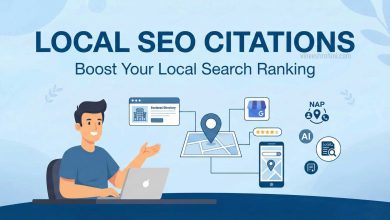What is Digital Advertising ? : Comprehensive Guide 2024
Digital Advertising : Digital advertising, also referred to as online advertising, is the practice of delivering promotional content through digital channels to target audiences. It has revolutionized the way businesses connect with consumers, making it a cornerstone of modern marketing strategies.
Table of Contents
This essay explores the concept of digital advertising, its history, types, benefits, challenges, and future trends.
The Evolution of Advertising into the Digital Realm
Advertising has always been a crucial tool for businesses to create awareness about their products and services. Traditional advertising mediums such as newspapers, radio, and television were the dominant platforms for decades. However, the advent of the internet in the late 20th century introduced new possibilities for marketing.
Also Read :: Why SEO is Important ?
The first banner ad appeared in 1994 on the website HotWired, marking the beginning of digital advertising. As technology evolved, digital advertising expanded to include search engines, social media platforms, mobile apps, and video streaming services. Today, digital advertising is an essential part of the marketing ecosystem, with global spending exceeding hundreds of billions of dollars annually.
Key Characteristics of Digital Advertising

Digital advertising distinguishes itself from traditional methods through several unique features:
- Interactivity: Unlike traditional ads, digital ads often encourage audience participation, such as clicking on a link, filling out a form, or sharing content.
- Targeted Reach: Advanced algorithms and data analytics allow advertisers to target specific demographics, interests, and behaviors.
- Real-time Metrics: Digital platforms provide instant insights into ad performance, including clicks, impressions, and conversions.
- Cost Efficiency: With pay-per-click (PPC) and other performance-based models, advertisers can control budgets more effectively.
- Global Accessibility: The internet enables businesses to reach audiences worldwide, breaking geographical barriers.
Types of Digital Advertising
Digital advertising comprises various formats, each suited to different goals and audiences.
1. Search Engine Advertising
Search engine advertising, or pay-per-click (PPC), involves placing ads on search engine results pages (SERPs). Platforms like Google Ads and Bing Ads allow advertisers to bid on keywords relevant to their offerings. When users search for these keywords, the ads appear alongside organic results.
- Benefits: High intent targeting and measurable results.
- Challenges: Competitive bidding can drive up costs for popular keywords.
2. Display Advertising
Display ads are visual ads that appear on websites, apps, or social media platforms. They include banners, sidebars, and pop-ups.
- Benefits: Excellent for brand awareness and visual appeal.
- Challenges: Ad blockers and banner blindness may reduce effectiveness.
3. Social Media Advertising
Social media platforms like Facebook, Instagram, LinkedIn, and TikTok enable businesses to create ads targeting their users. These ads can take the form of videos, carousels, or sponsored posts.
- Benefits: Highly targeted and engaging formats.
- Challenges: Constant algorithm changes can impact ad visibility.
4. Video Advertising
Video ads, often seen on platforms like YouTube, Vimeo, or within streaming services, are effective for storytelling and demonstrating products.
- Benefits: High engagement rates and emotional connection.
- Challenges: Higher production costs compared to static ads.
5. Native Advertising
Native ads blend seamlessly with the content of the platform where they appear. Examples include sponsored articles or recommendations on content websites.
- Benefits: Non-intrusive and better user experience.
- Challenges: Requires careful alignment with platform content.
6. Affiliate Marketing
In affiliate marketing, businesses reward affiliates for driving traffic or sales through their promotional efforts. This model is performance-based, often paying per sale or lead.
- Benefits: Cost-effective with low upfront investment.
- Challenges: Requires finding reliable affiliates.
7. Email Advertising
Email advertising involves sending promotional messages to a targeted list of recipients. Newsletters, special offers, and product updates are common examples.
- Benefits: Direct communication with a loyal audience.
- Challenges: Risk of being marked as spam if not done correctly.
8. Influencer Marketing
Collaborating with influencers who have large followings on social media platforms can amplify a brand’s reach.
- Benefits: Authentic engagement with niche audiences.
- Challenges: Ensuring brand alignment and ROI measurement.
The Benefits of Digital Advertising

1. Precise Targeting
Advertisers can use demographic, geographic, behavioral, and psychographic data to reach specific audiences. This ensures marketing budgets are spent efficiently.
2. Scalability
Digital advertising campaigns can easily scale to match business needs, from local outreach to global campaigns.
3. Measurable Results
Digital platforms provide detailed analytics, such as click-through rates (CTR), cost per acquisition (CPA), and return on ad spend (ROAS).
4. Cost-Effectiveness
With options like PPC, businesses only pay when users interact with ads, making it suitable for businesses of all sizes.
5. Flexibility and Customization
Ad content and strategies can be tailored to suit different audiences, platforms, and objectives.
6. Enhanced Engagement
Interactive formats, such as polls or video ads, allow for higher user engagement compared to static formats.
Challenges in Digital Advertising
Despite its advantages, digital advertising has its challenges:
1. Ad Fatigue
Excessive exposure to ads can lead to ad fatigue, where users start ignoring or actively avoiding ads.
2. Ad Blockers
The use of ad-blocking software reduces the reach and visibility of ads, particularly display ads.
3. Privacy Concerns
Stricter privacy laws like GDPR and CCPA have impacted how businesses collect and use data for targeting.
4. Increasing Competition
The growing adoption of digital advertising has made it more competitive, driving up costs for popular ad spaces.
5. Platform Dependence
Relying on platforms like Google or Facebook can be risky, as changes to their algorithms or policies can drastically affect campaigns.
Future Trends in Digital Advertising
The digital advertising landscape continues to evolve, driven by technological advancements and changing consumer behaviors. Key trends include:
1. Artificial Intelligence and Automation
AI is revolutionizing ad targeting, optimization, and personalization. Programmatic advertising, which uses AI to automate ad buying, is becoming more prevalent.
2. Voice Search and Smart Devices
As voice search grows in popularity, advertisers need to optimize content for voice-based queries.
3. Augmented Reality (AR) and Virtual Reality (VR)
AR and VR offer immersive ad experiences, allowing users to interact with products virtually before purchasing.
4. Shoppable Content
Interactive content that enables users to shop directly from ads is gaining traction, particularly on social media.
5. Focus on Privacy
As privacy concerns rise, platforms are adopting new approaches to targeting, such as Google’s Federated Learning of Cohorts (FLoC).
6. Sustainability and Social Responsibility
Brands are increasingly aligning their advertising messages with social and environmental causes to resonate with conscious consumers.
Conclusion

Digital advertising is a dynamic and ever-expanding field that has transformed how businesses connect with consumers. Its ability to target specific audiences, provide measurable results, and adapt to technological advancements makes it an indispensable tool in modern marketing.
Buy Now :: Ecommerce Website With 100 Products
However, it also comes with challenges, such as privacy concerns and increasing competition. To remain effective, businesses must stay informed about trends and innovate their approaches. As technology continues to evolve, digital advertising will undoubtedly play a central role in shaping the future of marketing.



